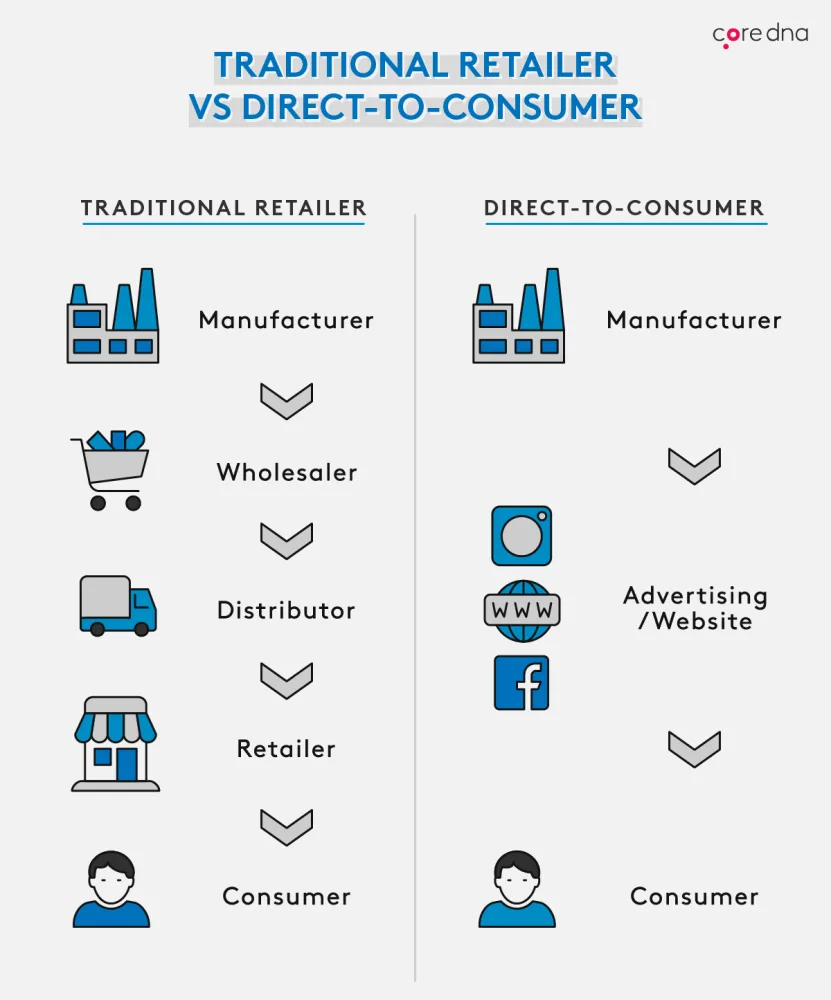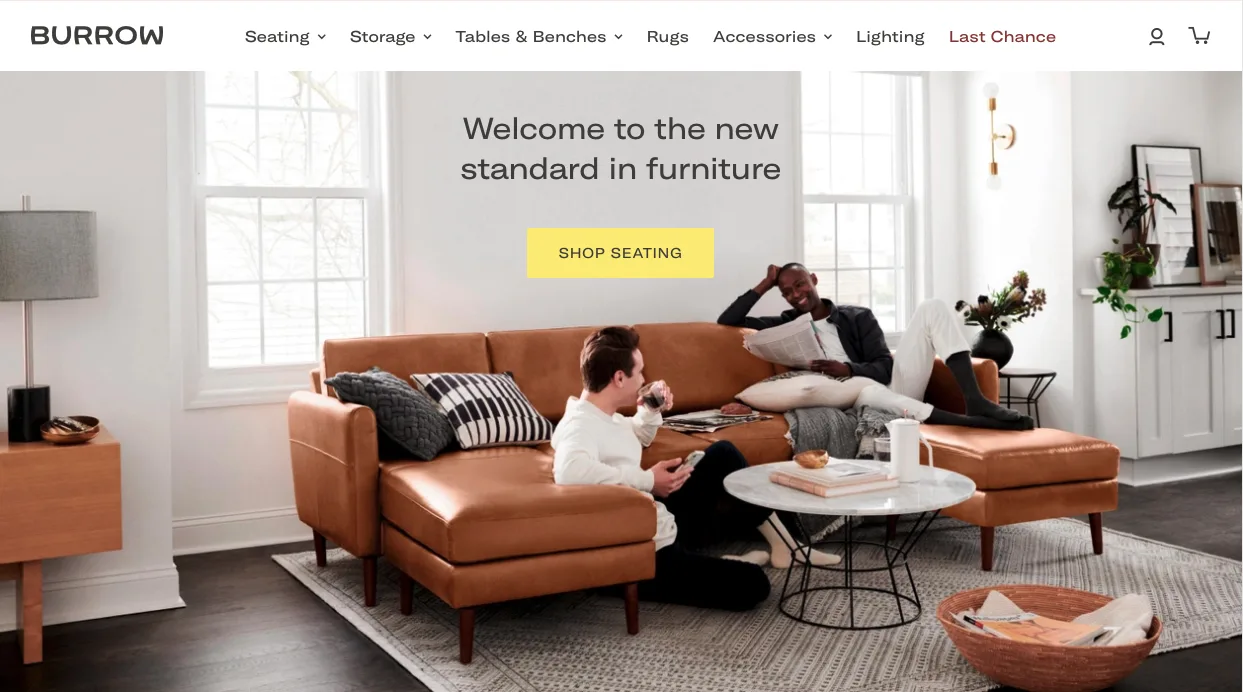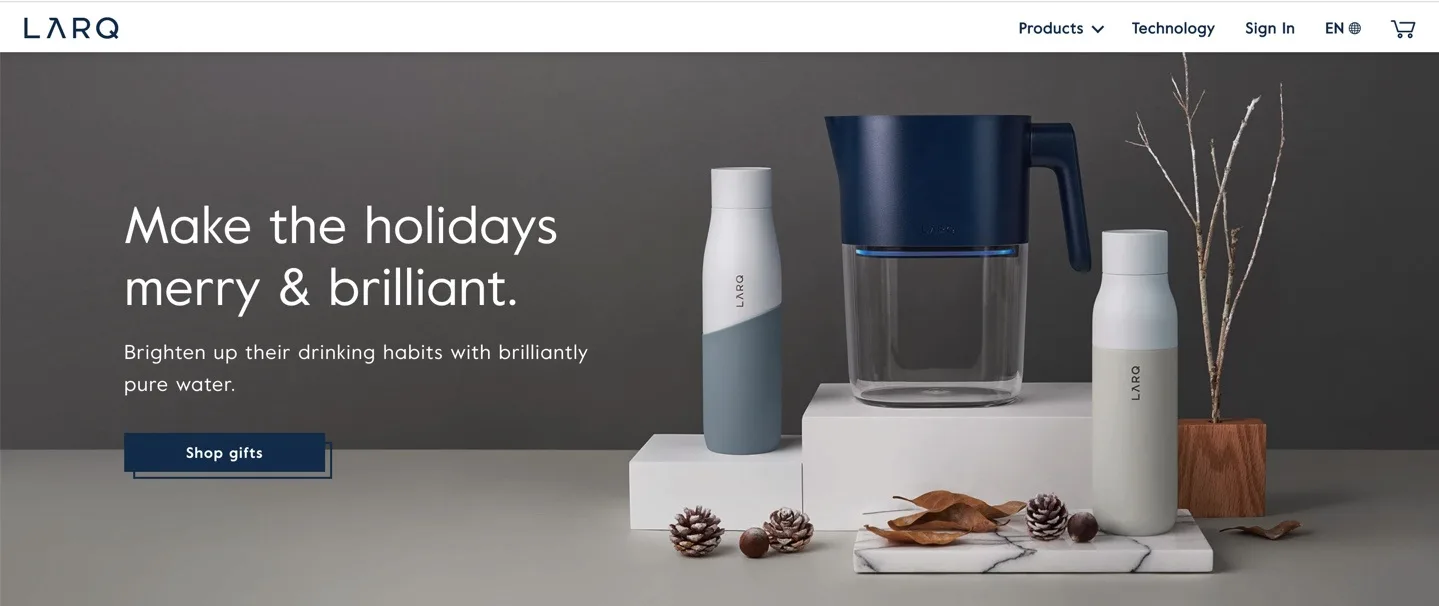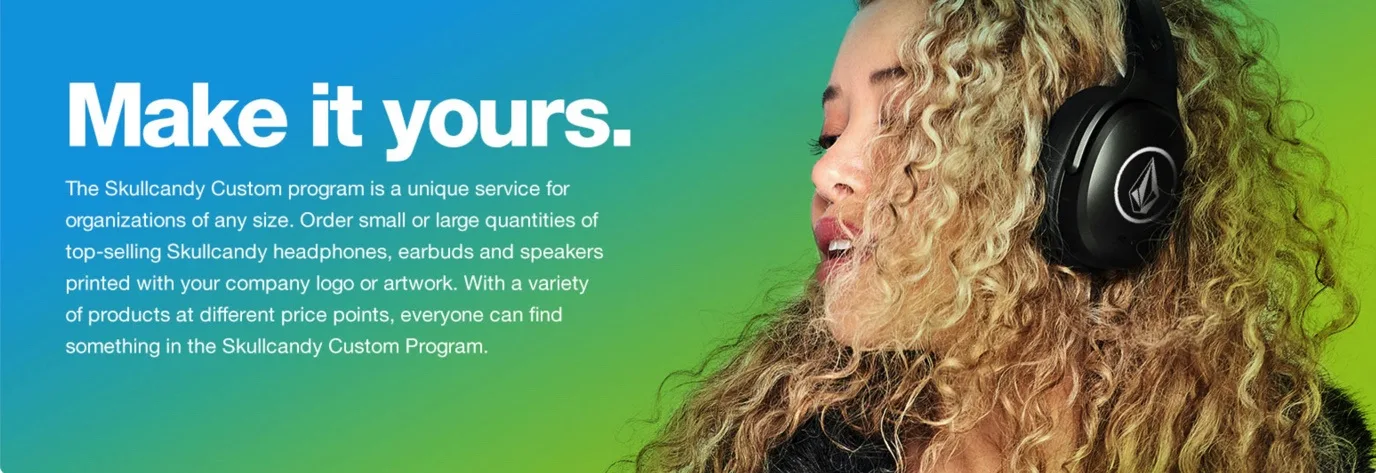With many retailers scaling back brick-and-mortar stores during the pandemic, manufacturers faced increasing competition for limited shelf space. Yet, with physical stores closing and online shopping increasing, the past year has presented a prime opportunity for manufacturers to join the ecommerce economy.
Instead of relying on middlemen to get their products to customers, manufacturers are increasingly taking a direct-to-consumer (DTC) approach, giving them complete control over their customer relationships, brand messaging and pricing. So, it’s no surprise that 54% of manufacturers want to sell directly to consumers.
But selling directly to consumers doesn’t just benefit the manufacturer. With access to more products and lower pricing, customers are increasingly looking to purchase straight from a brand’s online store or social media page. In fact, two-thirds of US shoppers said they expect direct connectivity with brands, and 81% plan to purchase from a DTC brand in the next five years.
And while direct-to-consumer is still a fairly new model in the manufacturing industry, you don’t have to be a big-name brand to be successful — thanks to ecommerce technology, the barrier to entry is quite low.
“Entrepreneurs no longer need retail shelf space or a huge ad budget or their own factory to take on corporate giants,” says Lawrence Ingrassia, author of Billion Dollar Brand Club. Instead, all you need is an online store and the resources to manage your business operations.
If you’re a manufacturer looking to take control of your business and sell directly to customers, keep reading to learn how to get started and what benefits to expect.
The Manufacturer-to-Consumer Business Model
So how does manufacturer-to-consumer — aka M2C — selling work?
In the typical retail model, manufacturers sell their product to wholesalers, distributors and retailers, who then sell those products to customers through brick-and-mortar or online retail stores. However, the manufacturer-to-consumer business model removes the middlemen so that manufacturers can sell directly to the consumer (D2C).

Above all other benefits, this model allows for a more direct relationship between the customer and manufacturer, creating a continuous feedback loop so that manufacturers can better cater to their customers’ needs. Plus, by cutting out the intermediaries, manufacturing companies can provide competitive pricing and innovative marketing strategies, giving them a chance to compete with industry retail giants.
From 2019 to 2020, US digital M2C sales experienced 45.5% growth, and by 2023, sales are expected to reach a whopping $175 billion — which means there’s a huge opportunity for M2C businesses to have a piece of the pie.

How Manufacturers Can Sell Directly to Consumers
Before transitioning from a traditional retail model to M2C, it’s important to first get a lay of the land. Selling to wholesalers and retailers is not the same as selling to a consumer, so there are some things to keep in mind as you’re plotting out your business plan.
Here are seven tips and strategies to get you started on your M2C journey.
1. Identify gaps in the market.
One of the surest routes to failure is diving into a market without any prior research. While it may take some time, conducting in-depth research before launching your business is the best way to ensure you’re heading in the right direction. Make sure there is a consumer demand for your product, and familiarize yourself with potential competitors.
Especially if you’re a small business or startup, try to avoid harsh competition with retail giants like Amazon and Wal-Mart by finding a gap in the market with few competitors and lots of opportunity for growth. The less you have to worry about the competition, the more you’ll be able to focus on innovating your business.
BigCommerce merchant Burrow is a prime example of this. After being frustrated by expensive, low-quality and inconvenient furniture, the founders of Burrow saw an opportunity to create a furniture brand unlike any other.
Using a different approach to furniture design, Burrow offers high-quality, modular furniture that can be separated into components and easily moved. By identifying the gap in the furniture market, Burrow has been able to stand out from the crowd and create a new market entirely.

2. Recruit and establish objectives.
Switching to a M2C business model doesn’t just change who you’re selling to — it also requires a changed mindset for the whole organization, so it’s important that all stakeholders are on board.
Of course, if you still have existing partnerships or contracts with retailers, this doesn’t mean you need to sever these relationships right off the bat. Rather, it could be a great opportunity to leverage your M2C channels and supplement existing revenue streams. Nonetheless, when transitioning to M2C, defining your objectives and communicating them to your stakeholders is key. As a team, decide the why behind becoming a M2C business. Whether it’s to test out a new consumer product or service, form better relationships with your end consumers or become more competitive, it’s important that everyone in your organization is moving toward the same goal.
3. Understand the needs and desires of the audience.
Undoubtedly, the most important stakeholder in an M2C business is the customer, and it’s your job to ensure that your product meets their needs.
On top of researching market gaps, it also helps to understand who your customers are and how they make purchasing decisions. Using analytics to track consumer behavior, you can determine where your target customers are spending their time and how you can better cater to their needs.
4. Use the right channels to connect with your audience.
One of the greatest benefits of going M2C is the opportunity to form a deeper connection with your audience and interact with them on a more personal level. But in order to form these connections, you first have to know the right channels to get you there.
Research how your customers prefer to buy and what social media platforms they spend their time on. Do they discover new products on Instagram? Are they active on LinkedIn? Do they buy primarily from Amazon?
Of course, it might be a little too ambitious to invest in every channel. In fact, spreading yourself too thin will likely only lead to wasted time and money. Instead, handpick a few channels that hold the most promise, and run with those.
Regardless of the channels you choose, make sure you’re delivering a seamless experience across all touchpoints. By taking an omnichannel approach, you’ll be able to create a consistent brand message everywhere you sell.
LARQ, a self-cleaning water bottle brand, does this by promoting its brand across Twitter, YouTube, Instagram Shoppable Posts and Facebook Shop. With multiple channels for customers to learn about the brand, LARQ is able to better connect with its target audience and provide them with a better experience.

5. Get the timeline right.
When transitioning from a traditional manufacturing business to a full-fledged M2C brand, timing is everything.
If your customers don’t know when your product line is launching (if they know at all) — that’s a problem. So don’t be shy about promoting your big launch day! Build anticipation by launching on a holiday or planning an event or conference, and promote across social media channels with video teasers, product sneak-peaks and giveaways to get your future customers excited to shop the new line.
6. Let customers personalize.
Shopping for a product should be a fun, exciting process, and what’s more exciting than being able to make a product uniquely your own?
Giving customers the option to customize products not only gives you an edge over the competition, but it provides valuable insight into what your customers actually want. By tracking customers’ personalized products, you can find out what are the most popular colors, styles, sizes and other product specifications.
According to a 2019 study by Deloitte, 36% of customers expressed interest in buying a personalized product, and 48% said they would be willing to wait longer for a personalized product or service.
Skullcandy, a lifestyle audio brand, offers a customer-centric experience by letting individual customers and organizations personalize their products. All you have to do is fill out a form on Skullcandy’s website with the product you’d like to customize, your desired color and logo the quantity you’d like to purchase.

7. Use the right tech.
As you embark on your digital transformation, having the right tech in place will make the transition infinitely smoother. Although selling directly to the consumer means you’ll have more personal connections with your shoppers, it also means you’ll have some added complexity, such as managing nearly the entire supply chain and other business operations.
From activities like real-time payments to analyzing big data to sales order automation, tech is the glue that keeps your business together, so it’s important that you choose the right tools.
And the most important place to start is choosing the right ecommerce platform to launch your online store.
When evaluating your options, remember that there isn’t a one-size-fits-all platform. There are a plethora of ecommerce solutions on the market, so prioritize the features and functionalities that are crucial for your business, and find the platform that best meets your needs.
However, we think BigCommerce has something for every merchant.
As an Open SaaS ecommerce platform, BigCommerce has all the benefits of a SaaS platform — such as a hosting provider and a lower total cost of ownership — and the flexibility of an open-source platform. Adaptable for both small and large businesses, BigCommerce’s open API allows merchants to use custom apps, ERP integrations or partner integrations without the additional cost and headache. Plus, as a leading headless commerce provider, BigCommerce’s decoupled frontend and backend allows merchants to test out new technologies and customize their websites. Headless infrastructure provides greater flexibility for content delivery, as users can connect a CMS, DXP or IoT device for creating content- or experience-led commerce.
Benefits for the Consumer of Buying Directly From Wholesalers
With the M2C business model on the rise, the industry is becoming increasingly competitive for wholesalers and distributors. But amid the changing landscape, there are still several benefits that wholesalers can offer its customers that manufacturers cannot.
1. One-stop shopping.
Unlike manufacturers, who only carry products from their own brand, wholesalers and distributors typically house a variety of brands and product options, making it easier for customers to find everything they need on one website. Especially at big-box stores like Wal-Mart or Target, customers can conveniently purchase multiple brands and brands rather than purchasing from multiple manufacturer websites.
2. Price comparison.
Along with one-stop shopping comes the ability to compare prices more easily. Since wholesalers and retailers typically carry a larger variety of similar products from multiple brands, customers have more options to choose from and thus more freedom to choose the product that meets their budget.
3. Easier returns and services.
Since many wholesale and retail stores often have a brick-and-mortar location, customers usually have the option to make purchases online and pick-up or return in stores. Plus, customers can see and test the product in-person before landing on a final purchasing decision.
Benefits for the Consumer of Buying Directly From Manufacturers
Before M2C selling, manufacturers only made a small profit compared to that of wholesalers and retailers, and the manufacturer needed these middlemen in order to get their products in front of customers. However, the M2C model has removed the barrier for manufacturers, allowing these brands to interact directly with consumers and make more sales — and this brings advantages for both manufacturers and customers alike.
1. Manufacturers offer competitive pricing.
Since manufacturers don’t have to worry about the overhead costs of maintaining a brick-and-mortar store, these brands often have the wiggle room to lower their prices. By cutting out the intermediaries and wholesaler fees, manufacturing companies can offer competitive pricing, giving them a chance to compete with big-name retailers.
2. Brands carry every product while retailers usually don’t.
Especially if a customer has already tested out one of your products and loves your brand, they’ll likely want to explore the rest of your product line, too.
Unfortunately, many wholesalers and retailers typically only carry specific products from a brand’s line, so customers are often limited on the products they can purchase. If a retailer only carries shirts and jackets from your manufacturing brand, but the customer is searching for pants, then the best place for them to look is your brand website. Since your online store is solely dedicated to selling your products, then the customer should never have to worry about finding the product they’re looking for.
And this includes offering a variety of colors, styles and sizes. Since retailers often only sell the most popular styles and colors, customers can shop straight from the manufacturer to get access to the entire collection.
3. Shoppers want to connect with your brand.
When brands are loyal to their customers, their customers are loyal to the brand. More than three quarters of shoppers (76%) prefer to buy from brands they feel connected to, and 57% are more likely to spend more with a brand when they feel connected.
Luckily for manufacturers, connecting more deeply with customers is at the heart of the M2C model. By skipping the middleman, selling directly to customers allows manufacturers to create real relationships with your customers and hopefully turn them into brand advocates down the line.
The Final Word
Although much more common today, the manufacturer-to-consumer trend was originally a significant departure from the traditional model. And if you’re a manufacturing brand thinking about going M2C, this can feel like a big jump.
While removing the middlemen from your supply chain does come with its perks — such as deeper customer relationships and the ability to offer lower pricing — it also comes with its challenges. Especially as a small business, lacking the right tech or the bandwidth to manage operations are roadblocks that you’ll need to address.
But if you’ve decided to make the move and start launching your M2C site, luckily, you don't have to go it alone. With the help of this guide and a commitment to serving your customers well, you’ll be able to embark on your M2C journey with full confidence.